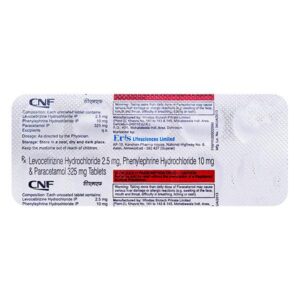PHENYLEPHRINE + PARACITAMOL + FEXOFENADINE HCL
Phenylephrine: Phenylephrine is a medication commonly used as a decongestant and nasal spray. It works by constricting the blood vessels in the nasal passages, which helps reduce swelling and congestion.
This drug is used to relieve symptoms caused by conditions such as allergies, hay fever, and the common cold. It can also be used as a nasal decongestant prior to certain medical procedures.
Phenylephrine is available in various forms, including tablets, capsules, nasal sprays, eye drops, and injections. The dosage depends on the specific form and condition being treated. For nasal sprays, the recommended dose is typically one or two sprays into each nostril every 4 hours, not exceeding more than 6 doses in a 24-hour period.
Some common side effects of phenylephrine include increased blood pressure, headache, dizziness, and nervousness. Nasal sprays may cause a temporary burning or stinging sensation in the nose. Prolonged use of nasal decongestants can lead to a rebound effect where congestion worsens once the medication is stopped.
In some cases, phenylephrine can cause severe side effects such as chest pain, rapid or irregular heartbeat, severe headache, or difficulty breathing. If any of these occur, it is important to seek immediate medical attention.
It’s worth noting that phenylephrine should be used with caution in individuals with certain medical conditions, such as high blood pressure, heart disease, and diabetes. It may also interact with other medications, so it is important to inform your healthcare provider about all the medications you are taking before starting phenylephrine.
Paracitamol: Paracetamol, also known as acetaminophen, is a widely used over-the-counter medication for pain relief and fever reduction. It belongs to the class of drugs known as analgesics (pain relievers) and antipyretics (fever reducers).
Paracetamol’s exact mechanism of action is not fully understood. It is believed to work primarily by inhibiting the production of certain chemicals, called prostaglandins, in the brain that are responsible for pain and fever. By reducing the production of these chemicals, paracetamol helps to alleviate pain and reduce fever.
The standard adult dose of paracetamol is usually 500-1000mg every 4-6 hours, with a maximum daily dose of 4,000mg (4 grams). It is available in various forms such as tablets, capsules, liquid suspensions, and suppositories.
Paracetamol is commonly used to relieve mild to moderate pain such as headaches, toothaches, menstrual cramps, and muscle aches. It is also effective in reducing fever in conditions such as colds, flu, and other viral or bacterial infections.
While paracetamol is generally considered safe when used as directed, it can have side effects, although they are rare. Potential side effects may include allergic reactions, such as rash or itching, but these are uncommon. Very high doses of paracetamol or long-term misuse may cause liver damage or liver failure, but this is extremely rare if the recommended dose is followed.
Paracetamol is generally well-tolerated and is one of the first-line options for pain relief and fever reduction. However, it is important to follow the recommended dosage guidelines and to avoid exceeding the maximum daily dose to minimize the risk of side effects. If you have any specific concerns or questions about using paracetamol, it is advisable to consult with a healthcare professional.
Fexofenadine Hcl: Fexofenadine HCl is an antihistamine drug that is commonly used for the treatment of allergic rhinitis (hay fever) and chronic idiopathic urticaria (hives). It is sold under the brand name Allegra.
The drug works by blocking the action of histamine, a substance in the body that is responsible for causing allergy symptoms such as sneezing, itching, runny nose, and watery eyes. By inhibiting histamine, Fexofenadine helps to relieve these symptoms and provide relief to the patient.
The usual recommended dose of Fexofenadine HCl for adults and children aged 12 years and older is 60 mg twice daily or 180 mg once daily. For children aged 6 to 11 years, the recommended dose is 30 mg twice daily. It is important to follow the dosage instructions provided by the healthcare provider or as mentioned on the medication label.
Common side effects of Fexofenadine HCl include headache, drowsiness, dizziness, nausea, and dry mouth. These side effects are usually mild and temporary. In rare cases, serious side effects such as allergic reactions, difficulty breathing, and chest tightness may occur. It is important to seek medical attention if any severe side effects are experienced.
Fexofenadine HCl is generally well-tolerated, but it may interact with certain medications, so it is important to inform the healthcare provider about all the other drugs being taken. It is also essential to disclose any existing medical conditions, especially kidney disease or any allergies, before starting the medication.
Overall, Fexofenadine HCl is an effective and widely used medication for the relief of allergic rhinitis and chronic urticaria. However, it is recommended to consult with a healthcare professional before starting or making any changes to the medication regimen.

